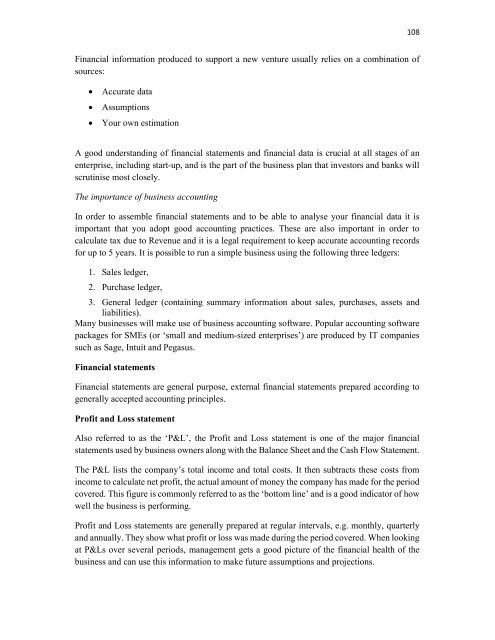and Music
Omega-Book
Omega-Book
Create successful ePaper yourself
Turn your PDF publications into a flip-book with our unique Google optimized e-Paper software.
108<br />
Financial information produced to support a new venture usually relies on a combination of<br />
sources:<br />
Accurate data<br />
Assumptions<br />
Your own estimation<br />
A good underst<strong>and</strong>ing of financial statements <strong>and</strong> financial data is crucial at all stages of an<br />
enterprise, including start-up, <strong>and</strong> is the part of the business plan that investors <strong>and</strong> banks will<br />
scrutinise most closely.<br />
The importance of business accounting<br />
In order to assemble financial statements <strong>and</strong> to be able to analyse your financial data it is<br />
important that you adopt good accounting practices. These are also important in order to<br />
calculate tax due to Revenue <strong>and</strong> it is a legal requirement to keep accurate accounting records<br />
for up to 5 years. It is possible to run a simple business using the following three ledgers:<br />
1. Sales ledger,<br />
2. Purchase ledger,<br />
3. General ledger (containing summary information about sales, purchases, assets <strong>and</strong><br />
liabilities).<br />
Many businesses will make use of business accounting software. Popular accounting software<br />
packages for SMEs (or ‘small <strong>and</strong> medium-sized enterprises’) are produced by IT companies<br />
such as Sage, Intuit <strong>and</strong> Pegasus.<br />
Financial statements<br />
Financial statements are general purpose, external financial statements prepared according to<br />
generally accepted accounting principles.<br />
Profit <strong>and</strong> Loss statement<br />
Also referred to as the ‘P&L’, the Profit <strong>and</strong> Loss statement is one of the major financial<br />
statements used by business owners along with the Balance Sheet <strong>and</strong> the Cash Flow Statement.<br />
The P&L lists the company’s total income <strong>and</strong> total costs. It then subtracts these costs from<br />
income to calculate net profit, the actual amount of money the company has made for the period<br />
covered. This figure is commonly referred to as the ‘bottom line’ <strong>and</strong> is a good indicator of how<br />
well the business is performing.<br />
Profit <strong>and</strong> Loss statements are generally prepared at regular intervals, e.g. monthly, quarterly<br />
<strong>and</strong> annually. They show what profit or loss was made during the period covered. When looking<br />
at P&Ls over several periods, management gets a good picture of the financial health of the<br />
business <strong>and</strong> can use this information to make future assumptions <strong>and</strong> projections.


